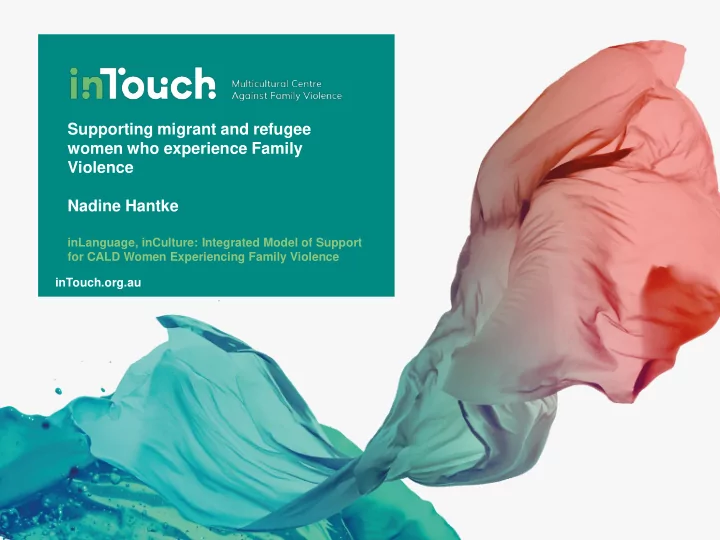

Supporting migrant and refugee women who experience Family Violence Nadine Hantke inLanguage, inCulture: Integrated Model of Support for CALD Women Experiencing Family Violence inTouch.org.au
Discussion Points » Barriers and challenges for women from migrant and refugee backgrounds 2
About inTouch A state-wide family violence organisation dedicated to the development and implementation of a number of culturally sensitive and holistic models of service provision to both victims and perpetrators of family violence. For women and children from diverse cultural backgrounds to be safe and free from family violence. 4
History of inTouch 2012: Legal centre Statewide service: established inTouch has evolved over inTouch is unique more than 30 years. in its multilingual, Started for and by multicultural service migrant women. The only delivery model, is accredited CALD Specialist the only FV family violence service in organisation that Victoria. offers integrated 2016: Increase in funding support that coming out of the RCFV saw an includes: case increase in staffing and the support, a legal establishment of the Capacity centre and Building Unit registered migration agent 4
Client Services: State-wide FV Support Program Case Work & advocacy Post-crisis recovery Court groups Support Program inTouch Legal Immigration Centre Assistance
About inTouch 1. Arabic 14. Nuer Languages 2. Juba Arabic 15. Punjabi The inTouch client services and legal centre 3. Bosnian 16. Russian teams between them can offer services in 26 4. Cantonese 17. Serbian community languages (refer right) and in 5. Croatian 18. Sinhalese English, of course. inTouch was able to assist in 6. Dari 19. Somali 6 out of the 7 most requested languages other 7. Dinka 20. Spanish than English. 8. Farsi 21. Tamil 9. Greek 22. Thai 10. Hindi 23. Turkish 11. Italian 24. Vietnamese 12. Macedonian 25. Urdu 13. Mandarin
Barriers & Challenges
Barriers & Challenges Examples: Knowing violence Migration Experience Awareness of systems Fear of authorities 9
Barrier – Knowing Violence – Gender inequality and male supremacy – “Abuse” vs “Discipline” – Tolerant and resilient to violence – Unrecognised forms of abuse “He wasn’t abusive, he only did it because I upset him and he is the man and the boss of the house.” “It is something I am used to as he is the man of the house and it is his job to discipline us.” 10
Barrier – Awareness of Systems • Lack of knowledge of laws against family violence in Australia • Lack of awareness of support systems available • Lack of awareness of victim’s rights and legal system ‘I knew nothing about Australian law, which is why I didn’t know what to do at the beginning’ ‘I lived in fear as I knew nothing’– Had I known about this, I would have left earlier’ 11
Barrier – Migration Experience » Pre-migration history and prior issues of torture and trauma might impact on their taking action » Loss and grief issues and the migration journey and experience » Changed gender roles might create further escalation of violence » Women hold themselves accountable to maintain the family structure and often blame themselves if failing to do so “In the refuge, I was told that I was safe and there was no reason to worry. But they didn’t understand that I was grieving again because this was yet another loss for me. My family was the only thing I brought with me from my home country that I could call my own – and I couldn’t keep my family together” . 12
Barrier – Fear of Authorities » Fear of authorities such as the police and courts because of experiences in the home country and may be reinforced by eroded relationships between authorities and minority communities in this country. » Fears can be further fueled by abusive partner » Mediation through family members, faith and community leaders might often be the first and preferred step to get support » Accessing protection through legal support could be the last option. ‘I was new in this country. I was very scared of the police…’ 13
Additional risk factors Definition of violence in relationships differs depending on culture, for example the question ‘has your partner/husband ever sexually assaulted you?’ will need unpacking Forced marriage Dowry abuse Complex family dynamics
Barriers to Risk Assessment • Denial and Minimization are powerful and at times unconscious coping strategies when living with excessive control and violence on a daily basis • Suicidal or homicidal ideation is not always observable • Terminologies such as ‘abuse’, ’domestic violence’, ‘threat’, may be too loaded because many victim/survivors may not share the same understanding of such words • In short term interventions there may not be enough rapport or trust established for women from refugee/migrant backgrounds to answer intensive questions as they appear in some risk assessment tools
Suggestions for Good Practice Avoid making assumption » that a woman from a CALD background has a clear understanding of the meaning of FV & its different types » that she has the full ability to understand information provided to her, incl. translated information; literacy issues in English or own language might exist Ask for clarification » Using interpreters to make sure that the information has been clearly understood by her and ask her to explain how she understands the information 16
Suggestions for Good Practice Cultural Responsiveness and Family Violence » Listen to her and don’t be afraid to ask questions and learn about her worldview and value system » Validate client’s experiences of the differences and reinforce laws in Australia but be mindful that victims rights might be a new concept for clients » Empower her with information on her rights and support system » She might have limited experience being asked opinions and making decisions – whilst this is difficult, direct questions are important » Provide her the resources even if she is not ready to take any actions » Explain confidentiality and limitations 17
Recommend
More recommend